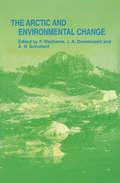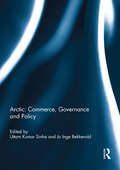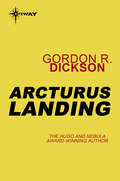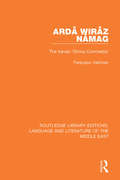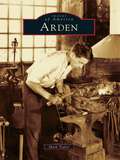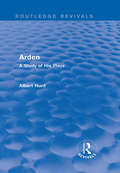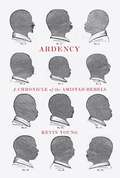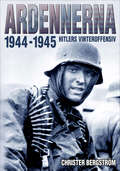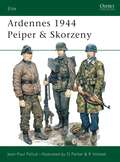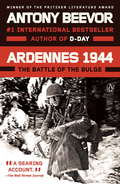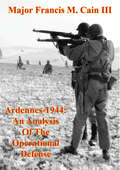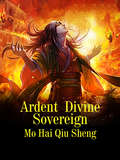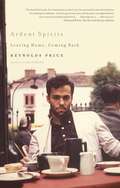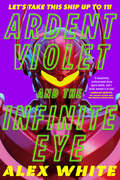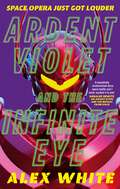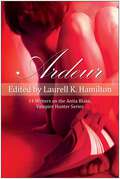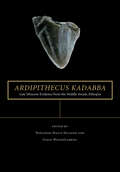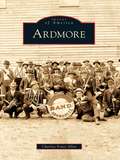- Table View
- List View
Arctic and Environmental Change
by J. A. DowdeswellThis timely book presents a wide-ranging review of Arctic environmental change in response to global warming, and gives a broad insight into the transformation of the Arctic which we can expect during the next century. It is in high northern latitudes that we can expect to observe global warming at its most powerful, making it a natural laboratory where climate changes and their impacts can be monitored and studied more readily than elsewhere in the world. Fourteen authoritative reviews cover the predictions of warming rates by General Circulation Models; variabilities in atmospheric circulation and moisture flux; the dynamics of the polar vortex in the Arctic and its role in ozone loss; the countervailing influence of air pollution in reducing solar irradiance; and the impact of climatic change on Arctic terrestrial and marine ecosystems. Also detailed are the thermohaline circulation of the ocean, the extent and thickness of sea ice, the sizes of glaciers and ice sheets, and the extent of permafrost. Moving to past changes, the records from Greenland ice cores and deep ocean drilling are reviewed for what they tell us about past climates and glaciation in the Arctic., The book paints a vivid and disturbing picture of the enhanced warming that can be expected in the Arctic relative to lower latitudes, and of the major impacts that this will have on the northern cryosphere. It will be an invaluable reference for anyone seeking a greater understanding of the factors and processes affecting the arctic environment, which may ultimately have a major impact on global climatic change.
Arctic: Commerce, Governance And Policy
by Uttam Kumar Sinha and Jo Inge BekkevoldIn May 2013, China, India, Japan, Singapore and South Korea (Asia 5) were given status as permanent observers in the Arctic Council. It was a symbolic and significant moment in the history of Arctic affairs. The list of stakeholders in the Arctic has now expanded to include both the Arctic littoral states and the five Asian states. The drivers and policies of these stakeholders on the Arctic vary, but research on climate change, possible changes to the global energy and minerals markets, adherence to international norms like the UNCLOS, and geopolitical considerations are issues of concern. This volume is based on the reviewed, revised and updated versions of papers presented at the roundtable on The Geopolitics of the Arctic: Commerce, Governance and Policy hosted by the Institute for Defense Studies and Analyses (IDSA) in New Delhi in September, 2013, in joint co-operation with the Fridtjof Nansen Institute (FNI), the Norwegian Institute for Defence Studies (IFS) and Peace Research Institute Oslo (PRIO).We hope that this book, with some compelling perspectives on a number of challenging issues, will help engage the policy community to identify and explore opportunities for international cooperation in the Arctic. This book was originally published as a special issue of Strategic Analysis.
Arcticologies: Early Modern Actions for Our Warmer World
by Lowell DuckertExploring the frozen past to rethink our warming future Do we really know what cold is? In Arcticologies, Lowell Duckert delves into early modern European texts to trace how representations of frigidity from the sixteenth and seventeenth centuries have contributed to historical understandings of climate and contemporary debates on climate change. Arguing that human culture and science are, in fact, indebted to the cold, Duckert suggests that these early depictions offer critical terms for advancing the aims of climate-change activism and assisting in counterapocalyptic thinking. An imaginative and intellectual journey, Arcticologies reveals the enduring role of cold in wide-ranging storytelling traditions. It draws on Shakespeare&’s Hamlet and Othello and the works of Thomas Dekker, René Descartes, and Thomas Hobbes and is informed throughout by contemporary Indigenous writing, including that of Sheila Watt-Cloutier and Leanne Betasamosake Simpson. In reflecting on these assorted accounts, Duckert sees cold as not only an environmental hardship but a source of cultural creativity and resilience, highlighting moments of collaboration between humans and the icy world, from arctic exploration to urban fairs on frozen rivers. Cold, Duckert makes clear, is more than the absence of warmth. Situating our contemporary obsession with impending planetary meltdown within the mazelike arcticologies of the past, Duckert shows how early modern cold brought about forms of curiosity, vocabulary, and interspecies relationality that can serve us today. In doing so, he asks us to identify what has been lost and who is at risk in today&’s thinning cold—while also urging us to imagine alternative futures focused not on inevitable and total collapse but on adaptation and preserving what remains.
Arcturian Songs Of The Masters Of Light: Arcturian Star Chronicles, Volume Four (The Arcturian Star Chronicles)
by Patricia PereiraIn 1987, medical transcriptionist Patricia Pereira suddenly started receiving telepathic communications from the star Arcturus and was requested to begin a series of galactically inspired manuscripts, Arcturian Songs of the Masters of Light is the fourth volume in the series. The mission of this series of books is to awaken us to our individual and collective spiritual obligation for the health and well being of our planet and all creatures who live upon her. Philosophical in cope, the essays in these books provide pragmatic, practical suggestions for emotional, mental physical, and spiritual transformation. They remind us of our familial relationships to beings of light who inhabit the great star nations. Arcturian Songs of the Masters of Light moves beyond solely Arcturian energies to incorporate high-level representatives of the brotherhoods of light, including Christ Essence and Sanat Kumara of the Order of Melchizedek.
Arcturus Landing
by Gordon R DicksonJohnny Parent was driven by a furious anger - anger against the cocky aliens from outer space and anger against the company which had hired him to build the space drive which would lift the quarantine against Earth.It was a tough problem - made tougher by the company's double-dealing. And Johnny didn't relish the thought of cracking it with a whip on his back and a knife at his throat.Then he stumbled upon an eccentric young playboy, his pretty but ambitious secretary and weird little alien with colossal strength. Together they plotted the piratical flight into space which would earn Earth its due place in the Universe.But they had to hurry - because the company's strong men were right behind them - and the sola time clock was running out!
Ardā Wirāz Nāmag: The Iranian 'Divina Commedia' (Routledge Library Editions: Language & Literature of the Middle East)
by Fereydun VahmanArdā Wirāz Nāmag or the Book of the Righteous Wirāz is an outstanding example of Iranian apocalyptic literature. It is in the Middle Persian (Pahlavi) language and was written probably during the later period of the Sasanian dynasty (AD 226-650). The Zoroastrian priests chose a man called Wirāz, the most righteous among them, to go to the spiritual realm to discover the truth of the religion. This book, first published in 1986, contains the observations of Wirāz’ divine journey and his description of heaven and hell. The basic MS. is K20 (Royal Library of Copenhagen) which is carefully compared with other MSS. The MS. is printed in facsimile, followed by transliteration and transcription following the MS. closely line by line. A full translation is given, and a commentary is included together with a glossary, bibliography and index.
Arden
by Mark TaylorThe Village of Arden was founded in 1900 by sculptor Frank Stephens and architect Will Price, both social reformers who sought to create an ideal society based on principles set forth by the American economist Henry George. With funding from Joseph Fels, a wealthy Philadelphia soap manufacturer who also financed C. R. Ashbee's Guild of Handicraft in England, Stephens and Price purchased 162 acres in northern Delaware and named their colony after the Arden forest of William Shakespeare's As You Like It. The community's motto was "You Are Welcome Hither," but Arden's founders did not anticipate the diverse and colorful mix of radicals and progressives their experiment would attract, including Upton Sinclair, muckraking author of The Jungle, and Scott Nearing, author of Living the Good Life. Through photographs, Images of America: Arden explores the early history of one of this country's most vibrant, yet little known, utopian experiments.
Arden Grey
by Ray StoeveAn insightful, raw YA novel about a young photographer navigating toxic relationships and how they influence her identity. <p><p>Sixteen-year-old Arden Grey is struggling. Her mother has left their family, her father and her younger brother won't talk about it, and a classmate, Tanner, keeps harassing her about her sexuality—which isn't even public. (She knows she likes girls romantically, but she thinks she might be asexual.) At least she's got her love of film photography and her best and only friend, Jamie, to help her cope. <p><p>Then Jamie, who is trans, starts dating Caroline, and suddenly he isn't so reliable. Arden's insecurity about their friendship grows. She starts to wonder if she's jealous or if Jamie's relationship with Caroline is somehow unhealthy—and it makes her reconsider how much of her relationship with her absent mom wasn't okay, too. <p><p>Filled with big emotions, first loves, and characters navigating toxic relationships, Ray Stoeve's honest and nuanced novel is about finding your place in the world and seeking out the love and community that you deserve.
Arden: A Study of His Plays (Routledge Revivals)
by Albert HuntJohn Arden was one of the major playwrights to have emerged during the 1950s, yet his work has arguably been misunderstood. In this book, first published in 1974, Albert Hunt’s primary concern is to relate the plays written by John Arden alone, as well as those written in collaboration with Margaretta D’Arcy, both to Arden’s whole concept of theatre, and to his social and political attitudes. The book begins with a biographical introduction, followed by a play-by-play study of Arden’s work and a survey of the impact of his plays in performance, alongside fascinating images. Celebrating the work and life of the playwright, this timely reissue will be of particular value to students of theatre studies as well as professional actors with an interest in John Arden’s plays and theatrical ideologies.
Ardency: A Chronicle of the Amistad Rebels
by Kevin Lowell YoungThe story of the African Americans who were abducted in the Amistad rebellion and jailed in New Haven,as a sequence of poems told in the voice of their interpreter that talks about captivity,hopes and fight for freedom.
Ardennerna 1944–1945: Hitlers Vinteroffensiv
by Christer BergströmI december 1944, precis i slutet av andra världskriget, chockade Hitler en hel värld med en mäktig tysk motoffensiv på västfronten. För andra gången i kriget blev de allierade helt överrumplade av att anfallet kom genom Ardennerna - det kuperade skogsområdet i östra Belgien och Luxemburg. De trodde fortfarande att det inte gick att föra fram en stor armé där, men blev snabbt varse hur fel de haft. Till synes oövervinneliga rullade stora tyska stridsvagnskolonner västerut. Den allra senaste tyska vapenteknologin koncentrerades till denna offensiv - väldiga Königstiger-stridsvagnar, en revolutionerande ny automatkarbin, flygande bomber och toppmoderna jetflygplan. Tyskarna satte till och med in eldrivna miniubåtar till stöd för Ardenneroffensiven! Halva amerikanska 1. armén kastades över ända och tusentals soldater togs tillfånga. Men i en liten stad, Bastogne, bet sig amerikanska fallskärmsjägare fast. Under tiden skyndade den hårdföre general Pattons armé till undsättning. Ändå krävdes det ett sex veckor långt, blodigt vinterslag - det mest förlustrika i den amerikanska arméns historia - innan tyskarna hade pressats tillbaka. Christer Bergström har intervjuat krigsveteraner, gått igenom stora mängder akrivmaterial samt rest och forskat i området. Resultatet är en stor mängd tidigare opublicerat material och nya rön som presenteras i denna genomgripande skildring av det dramatiska Ardennerslaget vintern 1944/1945. Ardennerslaget beskrivs ofta från den amerikanska utgångspunkten. Här ges båda sidors perspektiv lika stort utrymme. Inte minst lyfts veteranernas egna berättelser fram, vilket ger en mänsklig dimension åt detta blodiga slag. Boken är försedd med nära 400 illustrationer, inklusive ett stort antal aldrig tidigare publicerade fotografier, ett stort antal kartor av Samuel Svärd och 32 förstklassiga färgprofiler av stridsfordon och flygplan av den världskände profilartisten Claes Sundin. Christer Bergström, f. 1958, har ett 20-tal böcker om andra världskriget, flertalet utgivna på den internationella marknaden, bakom sig.
Ardennes 1944 Peiper & Skorzeny
by David Parker Jean-Paul PalludFrom the earliest planning stages of the German counter-offensive in the Ardennes during World War II (1939-1945), Hitler was convinced of the importance of taking the Meuse bridges. He resolved that, when his forces broke through the US lines, one special unit should be dressed in American uniforms and issued with American weapons and vehicles. In this guise they could take advantage of the surprise and shock of the breakthrough, and move forward to the Meuse bridges as if they were retreating Americans. Jean-Paul Pallud details their organisation and the fateful sequence of events that followed.
Ardennes 1944: The Battle of the Bulge
by Antony BeevorThe prizewinning historian and bestselling author of D-Day and Stalingrad reconstructs the Battle of the Bulge in this riveting new account. On December 16, 1944, Hitler launched his 'last gamble' in the snow-covered forests and gorges of the Ardennes in Belgium, believing he could split the Allies by driving all the way to Antwerp and forcing the Canadians and the British out of the war. Although his generals were doubtful of success, younger officers and NCOs were desperate to believe that their homes and families could be saved from the vengeful Red Army approaching from the east. Many were exultant at the prospect of striking back.The allies, taken by surprise, found themselves fighting two panzer armies. Belgian civilians abandoned their homes, justifiably afraid of German revenge. Panic spread even to Paris. While some American soldiers, overwhelmed by the German onslaught, fled or surrendered, others held on heroically, creating breakwaters which slowed the German advance. The harsh winter conditions and the savagery of the battle became comparable to the Eastern Front. In fact the Ardennes became the Western Front's counterpart to Stalingrad. There was terrible ferocity on both sides, driven by desperation and revenge, in which the normal rules of combat were breached. The Ardennes--involving more than a million men--would prove to be the battle which finally broke the back of the Wehrmacht. In this deeply researched work, with striking insights into the major players on both sides, Antony Beevor gives us the definitive account of the Ardennes offensive which was to become the greatest battle of World War II.From the Hardcover edition.
Ardennes-1944: An Analysis Of The Operational Defense
by Major Francis M. Cain IIIThis study examines the nature of the defense at the operational level of war by analyzing the Battle of the Bulge in Dec. 1944 using the concepts of blitzkrieg and "web" defense. The monograph begins by discussing the influence of defensive theory on the operational concepts of blitzkrieg and "web" defense. The German concept of blitzkrieg incorporates Clausewitz's theory of the offense by emphasizing surprise, speed, and concentration at the decisive point. The counter to the blitzkrieg offense is found in COL F.O. Miksche's concept of "web" defense. The Battle of the Bulge provides an excellent example of a "web" defense pitted against a blitzkrieg offense. The German blitzkrieg in the Ardennes in 1944 failed for many reasons: 1) Army Group B did not concentrate its strength against the most vulnerable section of the Allied line; 2) The rugged Ardennes terrain could be easily defended against attacks by mechanized forces; 3) Key American commanders (Eisenhower, Gerow, and Middleton) quickly recognized the value of holding several key road junctions (St. Vith, Malmedy, Bastogne, Marche, and Rochefort) which dominated movement through the Ardennes; 4) The Allies held the shoulders of the German penetration; 5) The Allies quickly concentrated armored and motorized units to blunt the German penetration; and 6) Army Group B lacked operational reserves and adequate logistic support. The analysis of the Ardennes shows that the defense is indeed the stronger form of war and that a "web" defense can be employed effectively against a blitzkrieg offense...The Allies effectively used a "web" defense to counter these threats. If NATO is to defeat a Soviet attack without resorting to the use of nuclear weapons, it must adopt a viable operational defensive concept. "Web" defense is such a concept.
Ardent Divine Sovereign: Volume 3 (Volume 3 #3)
by Mo HaiQiuShengCarrying adorable pets, attracting beauties, writing magnificent chapters, stepping on strong people, suppressing geniuses, and becoming an eternal tyrant. Grasping a lucky chance, obtaining some good fortune, defying the will of the heavens, advancing to the peak of martial arts. The path of the Blood God was desolate and withered. How could this be? Only I myself defy the will of the heavens.
Ardent Spirits
by Reynolds PriceIn his third volume of memoir, Reynolds Price explores six crucial years of his life -- his departure from home in 1955 to spend three years as a student at Oxford University; then his return to North Carolina to begin his long career as a university teacher. He gives often moving, and frequently comic, portraits of his great teachers in England -- such men as Lord David Cecil, Nevill Coghill, and W. H. Auden, who was the most distinguished English-language poet of those years. In London the poet and editor Stephen Spender becomes his first publisher and a generous friend who introduces him to rewarding figures like the essayist Cyril Connolly and George Orwell's encouraging widow, Sonia. He spends rich months traveling in Britain and on the Continent; and above all he undergoes the first loves of his life -- one with an Oxford colleague whom he describes as a "romantic friend" and another with an older man. Back in the States, in his first class at Duke he meets a startlingly gifted student in the sixteen-year-old Anne Tyler; and he soon combines the difficult pleasures of teaching English composition and literature with his own hard delight in learning to write a first novel. At the end of three lonely years, he completes the novel -- A Long and Happy Life -- and returns to England for a fourth year before his novel appears in Britain and America and meets with a success that sets the pace for an ongoing life of fiction, poetry, plays, essays, and translations (Ardent Spirits is his thirty-eighth volume). The droll memories recorded here amount to the unsurpassed -- and, again, often comical -- story of a writer's beginnings; and the young man who emerges has proven his right to stand by his fellows of whatever sex and goal. Ardent Spirits is a book that penetrates deeply into the life of a writer, a teacher, and a steadfast lover.
Ardent Spirits
by Reynolds PriceIn his third volume of memoir, Reynolds Price explores six crucial years of his life -- his departure from home in 1955 to spend three years as a student at Oxford University; then his return to North Carolina to begin his long career as a university teacher. He gives often moving, and frequently comic, portraits of his great teachers in England -- such men as Lord David Cecil, Nevill Coghill, and W. H. Auden, who was the most distinguished English-language poet of those years. In London the poet and editor Stephen Spender becomes his first publisher and a generous friend who introduces him to rewarding figures like the essayist Cyril Connolly and George Orwell's encouraging widow, Sonia. He spends rich months traveling in Britain and on the Continent; and above all he undergoes the first loves of his life -- one with an Oxford colleague whom he describes as a "romantic friend" and another with an older man. Back in the States, in his first class at Duke he meets a startlingly gifted student in the sixteen-year-old Anne Tyler; and he soon combines the difficult pleasures of teaching English composition and literature with his own hard delight in learning to write a first novel. At the end of three lonely years, he completes the novel -- A Long and Happy Life -- and returns to England for a fourth year before his novel appears in Britain and America and meets with a success that sets the pace for an ongoing life of fiction, poetry, plays, essays, and translations (Ardent Spirits is his thirty-eighth volume). The droll memories recorded here amount to the unsurpassed -- and, again, often comical -- story of a writer's beginnings; and the young man who emerges has proven his right to stand by his fellows of whatever sex and goal. Ardent Spirits is a book that penetrates deeply into the life of a writer, a teacher, and a steadfast lover.
Ardent Violet and the Infinite Eye (The Starmetal Symphony #2)
by Alex WhiteA ragtag band of musicians is all that stands in the way between an army of giant mechas and humanity's total destruction in the second book of this big-hearted, technicolor space opera trilogy by one of the most exciting voices in science fiction, Alex White. Ultra-glam enby pop star Ardent Violet thought they could catch a break and enjoy some time with their new boyfriend August Kitko after defeating the giant mechas hellbent on humanity's destruction. However, Ardent didn't count on their mecha allies summoning a host of extraterrestrials to defend Earth. Between the diplomatic entanglements of the newly-arrived alien Coalition, and a mysterious all-powerful AI establishing a base within their solar system, there's no rest for the wicked. When August makes a discovery that could turn the tide of the war, Ardent Violet finds themself back in the spotlight for an encore!The Starmetal Symphony August Kitko and the Mechas from Space Ardent Violet and the Infinite Eye For more from Alex White, check out: The Salvagers A Big Ship at the Edge of the Universe A Bad Deal for the Whole Galaxy The Worst of All Possible Worlds
Ardent Violet and the Infinite Eye: Starmetal Symphony, Book 2
by Alex WhiteIn this new wide-screen space opera, humanity has met its match. An alien race of enormous robotic AI have destroyed most of humanity's outposts. But, on the eve of the Earth's destruction, a musician made one last desperate attempt to reach out and convince one of humanity's enemies to switch sides. Now, earth just might have a chance to survive...A ragtag band of misfits is all that stands in the way between an army of giant mechas and humanity's total destruction in the second book of this big-hearted, technicolor space opera trilogy by one of the most exciting voices in science fiction, Alex White.Ultra-glam enby pop star Ardent Violet thought they could catch a break and enjoy some time with their new boyfriend August Kitko after defeating the giant mechas hellbent on humanity's destruction. However, Ardent didn't count on their mecha allies summoning a host of extraterrestrials to defend Earth.Between the diplomatic entanglements of the newly-arrived alien Coalition, and a mysterious all-powerful AI establishing a base within their solar system, there's no rest for the wicked.When August makes a discovery that could turn the tide of the war, Ardent Violet finds they are back in the spotlight for an encore!
Ardeur: 14 Writers on the Anita Blake, Vampire Hunter Series
by Laurell K. HamiltonLaurell K. Hamilton's Anita Blake, Vampire Hunter series is a literary sensation, thanks to its strong female hero, well-fleshed (both literally and literarily) characters and unabashed attitude toward sex. The world Hamilton has created is powerfully compelling and stunningly complex—and it gets deeper, richer and more perilous, with every book. Straddling the series' dominant themes of sex and power, Ardeur gives Anita fans a deeper look into the dynamics, both personal political, that have kept readers fascinated throughout the run of the series. Why is the ardeur the very best thing that could have happened to Anita, personally (aside from all the sex it requires her to have with hot men)? How is Anita's alternate United States a logical legal extension of our own? And as the series continues, what other bargains might Anita have to make with herself and others in order to keep the people she loves safe from harm? The collection includes essay introductions by Hamilton, giving context and extra insight into each essay's subject.
Ardian - The Sale of Diana
by Michael Roberts Paul A. GompersThe case focuses on a European private equity form - Ardian - and the process it uses to sell one of its portfolio companies, and the decisions around that sale. Key issues include the choice of an auction or acceptance of a pre-emptive bid, and the role of the portfolio company's management in the process. The case explores the kinds of influence company management can, and should, have in the sale process. The case also explores issues at the PE firm level, including the fact that the firm has recently been spun off out of its large parent financial services firm, and how the GP entity was valued during that spin-out.
Ardian: Portfolio Company Governance
by Lynn Sharp Paine Emer Moloney Tonia LabruyereLeaders of the mid cap buyout group at Ardian, the Paris-based private equity firm led by Dominique Senequier, have been asked to review and assess the governance model the firm uses for majority-owned companies in its portfolio. The case describes the governance model and then shows how it has worked in practice at two companies: Italy's orthopedic implant maker Lima Corporate and French chemical company Novacap. For each company, the case describes how Ardian decided on the investment and established a board of directors, and details the deliberations around some of the critical decisions made by each board during Ardian's tenure as majority shareholder. Through the two examples of Lima and Novacap, the case invites students to evaluate Ardian's approach to corporate governance in its portfolio companies and to recommend possible changes or improvements.
Ardian: Portfolio Company Governance (A)
by Lynn Sharp Paine Emer Moloney Tonia LabruyereLeaders of the mid cap buyout group at Ardian, the Paris-based private equity firm led by Dominique Senequier, have been asked to review and assess the governance model the firm uses for majority-owned companies in its portfolio. The case describes the governance model and then shows how it has worked in practice at two companies: Italy's orthopedic implant maker Lima Corporate and French chemical company Novacap. For each company, the case describes how Ardian decided on the investment and established a board of directors, and details the deliberations around some of the critical decisions made by each board during Ardian's tenure as majority shareholder. Through the two examples of Lima and Novacap, the case invites students to evaluate Ardian's approach to corporate governance in its portfolio companies and to recommend possible changes or improvements.
Ardipithecus kadabba: Late Miocene Evidence from the Middle Awash, Ethiopia (The Middle Awash Series)
by Yohannes Haile-Selassie Giday WoldegabrielThe second volume in a series dedicated to fossil discoveries made in the Afar region of Ethiopia, this work contains the definitive description of the geological context and paleoenvironment of the early hominid Ardipithecus kadabba. This research by an international team describes Middle Awash late Miocene faunal assemblages recovered from sediments firmly dated to between 5.2 and 5.8 million years ago. Compared to other assemblages of similar age, the Middle Awash record is unparalleled in taxonomic diversity, composed of 2,760 specimens representing at least sixty five mammalian genera. This comprehensive evaluation of the vertebrates from the end of the Miocene in Africa provides detailed morphological and taxonomic descriptions of dozens of taxa, including species new to science. It also incorporates results from analyses of paleoenvironment, paleobiogeography, biochronology, and faunal turnover around the Pliocene-Miocene boundary, opening a new window on the evolution of mammals, African fauna, and its environments.
Ardmore
by Charlsie Foust AllenAlthough part of the Chickasaw Nation, virgin soil lured pioneers into Indian Territory, and by 1900, intruders outnumbered Native Americans 10 to 1, building communities throughout Native American lands. In 1887, on a grassy prairie where buffalo had roamed, men gathered where the Santa Fe Railroad planned to build a station. By 1898, Ardmore was a thriving city with businesses, churches, electricity, and telephones. Under a new federal law in late 1898, Ardmore became an incorporated city. Several disasters including a massive explosion and two major fires almost destroyed the town, but the people who built Ardmore came from sturdy stock. After each disaster, they rebuilt, and Ardmore continued to prosper.
